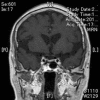Periodic hypokalemia associated with cyclic Cushing's syndrome
- PMID: 28509248
- PMCID: PMC5413677
- DOI: 10.1007/s13730-013-0090-1
Periodic hypokalemia associated with cyclic Cushing's syndrome
Abstract
A 69-year-old woman presented with periodic hypertension, edema, and hypokalemia that occurred within an interval of a few weeks. Her laboratory test values showed autonomously elevated plasma adrenocorticotropic hormone (ACTH) and cortisol concentrations. The patient's Cushingoid features were not evident on first admission. Several weeks later, in spite of constant oral potassium supplementation, severe hypokalemia recurred with Cushingoid features and worsening symptoms of leg edema and pigmentation, which spontaneously disappeared within a few days. Her periodic symptoms occurred in parallel with fluctuations of plasma ACTH and cortisol concentrations. A series of endocrinological and pituitary imaging findings led to a tentative diagnosis of cyclic Cushing's syndrome caused by ectopic ACTH secretion. However, chest and abdominal computed tomography did not reveal any candidate lesion. The patient's periodic hypercortisolemia and symptoms were well controlled after treatment with metyrapone plus dexamethasone. This is a very rare case of periodic hypokalemia and hypertension caused by cyclic Cushing's syndrome.
Keywords: Cyclic Cushing’s syndrome; Ectopic ACTH syndrome; Hypokalemia.
Figures
Similar articles
-
Effectiveness versus efficacy: the limited value in clinical practice of high dose dexamethasone suppression testing in the differential diagnosis of adrenocorticotropin-dependent Cushing's syndrome.J Clin Endocrinol Metab. 1997 Jun;82(6):1780-5. doi: 10.1210/jcem.82.6.3991. J Clin Endocrinol Metab. 1997. PMID: 9177382
-
[Cushing's syndrome: diagnostic exploration].Presse Med. 1994 Jan 8-15;23(1):43-8. Presse Med. 1994. PMID: 8127815 Review. French.
-
Failure of functional imaging with gallium-68-DOTA-D-Phe1-Tyr3-octreotide positron emission tomography to localize the site of ectopic adrenocorticotropic hormone secretion: a case report.J Med Case Rep. 2011 Aug 23;5:405. doi: 10.1186/1752-1947-5-405. J Med Case Rep. 2011. PMID: 21861919 Free PMC article.
-
Metyrapone-responsive ectopic ACTH-secreting pheochromocytoma with a vicious cycle via a glucocorticoid-driven positive-feedback mechanism.Endocr J. 2018 Jul 28;65(7):755-767. doi: 10.1507/endocrj.EJ18-0025. Epub 2018 May 15. Endocr J. 2018. PMID: 29760304
-
The differential diagnosis of Cushing's syndrome.Ann Endocrinol (Paris). 2001 Apr;62(2):173-9. Ann Endocrinol (Paris). 2001. PMID: 11353890 Review.
Cited by
-
Somatostatin Receptor-negative and Fluorodeoxyglucose-positron Emission Tomography-positive Lung Neuroendocrine Tumor G1 Exhibiting Cyclic Cushing's Syndrome.Intern Med. 2022 Dec 15;61(24):3693-3698. doi: 10.2169/internalmedicine.9238-21. Epub 2022 May 31. Intern Med. 2022. PMID: 35650126 Free PMC article.
-
Cyclic Cushing's Syndrome - A Diagnostic Challenge.Front Endocrinol (Lausanne). 2021 Apr 22;12:658429. doi: 10.3389/fendo.2021.658429. eCollection 2021. Front Endocrinol (Lausanne). 2021. PMID: 33967962 Free PMC article. Review.
References
-
- Ethier JH, Kamel KS, Magner PO, Lemann J, Jr, Halperin ML. The transtubular potassium concentration in patients with hypokalemia and hyperkalemia. Am J Kidney Dis. 1990;15:309–315. - PubMed
LinkOut - more resources
Full Text Sources
Other Literature Sources


